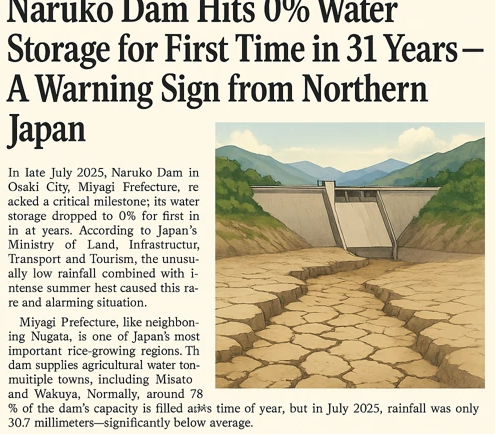
July 31, 2025
In late July 2025, Naruko Dam in Ōsaki City, Miyagi Prefecture, reached a critical milestone: its water storage dropped to 0% for the first time in 31 years. According to Japan’s Ministry of Land, Infrastructure, Transport and Tourism, the unusually low rainfall combined with intense summer heat caused this rare and alarming situation.
Miyagi Prefecture, like neighboring Niigata, is one of Japan’s most important rice-growing regions. The dam supplies agricultural water to multiple towns, including Misato and Wakuya. Normally, around 78% of the dam’s capacity is filled at this time of year, but in July 2025, rainfall was only 30.7 millimeters—significantly below average.
To keep rice crops alive during their crucial flowering stage, officials are now forced to release water from levels lower than what is normally used. Emergency measures are being taken, including coordination with nearby Iwadozawa Dam. Local authorities have also opened emergency consultation centers to help farmers manage water shortages.
The concern goes beyond just this year’s harvest. In 2024, Japan faced a rice shortage that caused a significant price increase, becoming a social issue. Now, many fear that the continued drought could lead to a repeat of those problems in 2025 and beyond.
The heat wave affecting the region is part of a broader pattern of climate anomalies. On July 29, Ōsaki recorded a record-breaking 37.5°C, while other parts of Miyagi experienced similarly extreme temperatures. For Sendai City, this was already the eighth “extremely hot day” (above 35°C) of the year—the most ever recorded.
Naruko Dam’s drying is not just a local incident—it is a reminder of how vulnerable our food systems are in the face of climate change. If the trend of hotter summers and less rainfall continues, even the most fertile lands in Japan may struggle to maintain stable rice production. Addressing climate change on a global scale has never been more urgent.
鳴子ダム、31年ぶりに貯水率0%に ― 北日本からの警告のサイン
2025年7月下旬、宮城県大崎市にある鳴子ダムは重要な節目に達しました。貯水率が0%にまで低下し、これは31年ぶりのことです。日本の国土交通省によると、異常に少ない降雨と激しい夏の暑さがこのまれで憂慮すべき状況を引き起こしました。
宮城県は、隣接する新潟県と同様に、日本でもっとも重要な米作り地域の一つです。このダムは、美里町や涌谷町を含む複数の町に農業用水を供給しています。通常、この時期には貯水容量の約78%が満たされていますが、2025年7月の降雨量はわずか30.7ミリメートルで、平均を大きく下回っていました。
稲の開花という重要な時期に作物を生かすため、当局は通常は使わない最低水位以下の水を放出せざるを得なくなっています。岩堂沢ダムとの連携を含む緊急対策が取られており、地元の当局は農民が水不足に対応できるよう、緊急相談窓口を開設しました。
懸念は今年の収穫にとどまりません。2024年、日本は米の不足に直面し、大幅な価格上昇を引き起こして社会問題になりました。今、多くの人が、続く干ばつが2025年以降にもその問題を再燃させるのではないかと心配しています。
この地域を襲っている熱波は、より広い気候異常の一部です。7月29日、大崎市では観測史上最高の37.5度を記録し、宮城県内の他の地域でも同様に極端な気温が観測されました。仙台市ではすでに今年8回目の猛暑日(35度以上)となり、観測史上最多となっています。
鳴子ダムの干上がりは、単なる地域的な出来事ではありません。それは、私たちの食料システムが気候変動にどれほど脆弱であるかを思い知らせるものです。もし、より暑い夏と少ない降水量の傾向が続くなら、日本でもっとも肥沃な土地でさえ安定した米の生産が困難になるかもしれません。地球規模での気候変動への対策は、かつてないほど急務となっています。
